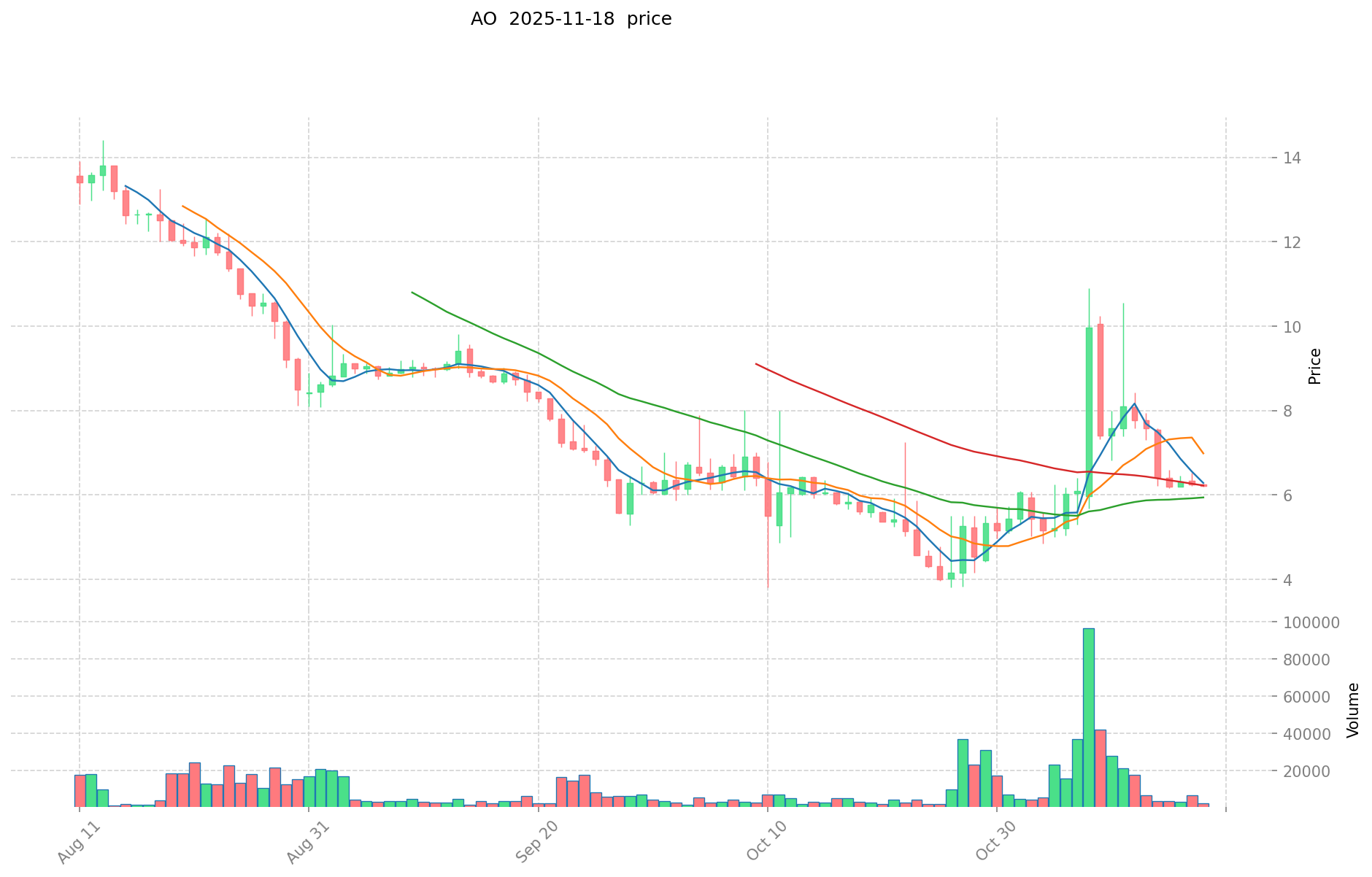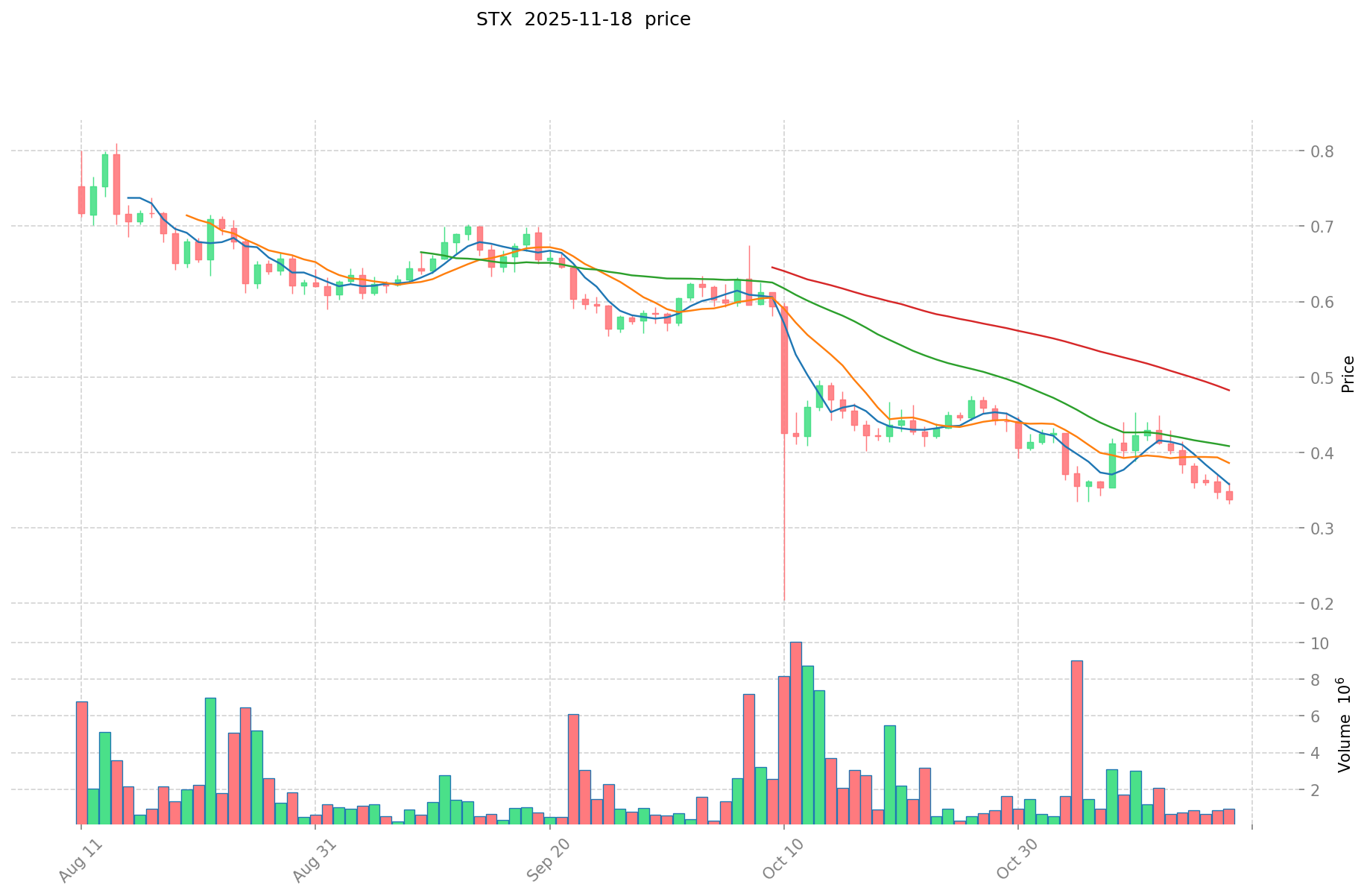AO vs STX: The Battle for Dominance in High-Performance Computing
Introduction: AO vs STX Investment Comparison
In the cryptocurrency market, the comparison between AO and STX has always been a topic that investors can't avoid. The two not only show significant differences in market cap ranking, application scenarios, and price performance, but also represent different positioning in crypto assets.
AO (AO): Since its launch, it has gained market recognition for its decentralized compute system.
Stacks (STX): Since 2019, it has been hailed as a new internet for decentralized applications, becoming one of the cryptocurrencies with high global trading volume and market capitalization.
This article will comprehensively analyze the investment value comparison between AO and STX, focusing on historical price trends, supply mechanisms, institutional adoption, technical ecosystems, and future predictions, and attempt to answer the question investors care about most:
"Which is the better buy right now?"
I. Price History Comparison and Current Market Status
AO and STX Historical Price Trends
- 2025: AO reached its all-time high of $28.32 on March 20, 2025.
- 2025: STX experienced a significant decline, dropping 81.16% over the past year.
- Comparative analysis: In the recent market cycle, AO dropped from its high of $28.32 to a low of $3.80, while STX fell from $3.86 to its current price of $0.3523.
Current Market Situation (2025-11-19)
- AO current price: $6.399
- STX current price: $0.3523
- 24-hour trading volume: $29,708.75597 (AO) vs $302,151.138438 (STX)
- Market Sentiment Index (Fear & Greed Index): 11 (Extreme Fear)
Click to view real-time prices:
- View AO current price Market Price
- View STX current price Market Price


Investment Value Analysis: AO vs STX
I. Core Factors Affecting AO vs STX Investment Value
Supply Mechanism Comparison (Tokenomics)
- Market risk factors significantly impact the fair value of financial instruments
- Strategic asset allocation plays a crucial role in determining investment returns
- 📌 Historical pattern: Broad market index investments help mitigate supply-related volatility
Institutional Adoption and Market Applications
- Institutional holdings: Portfolio managers like Steven Cohen's Point72 have disclosed positions in these markets
- Enterprise adoption: Integration into index funds tracking S&P 500 demonstrates mainstream acceptance
- Regulatory attitudes: SEC filings show increasing institutional transparency requirements
Risk Management and Diversification
- Asset diversification effectively reduces volatility and mitigates risks from single asset failures
- Broad-based index funds serve as a primary diversification strategy
- Market tracking objectives aim for daily tracking deviation under 0.2% and annual tracking error below 2%
Macroeconomic Factors and Market Cycles
- Investment decisions often delayed due to uncertainty factors
- Risk control mechanisms are central to investment strategy implementation
- Long-term participation allows for gradual asset accumulation despite market fluctuations
III. 2025-2030 Price Prediction: AO vs STX
Short-term Prediction (2025)
- AO: Conservative $6.06 - $6.38 | Optimistic $6.38 - $7.21
- STX: Conservative $0.19 - $0.35 | Optimistic $0.35 - $0.52
Mid-term Prediction (2027)
- AO may enter a growth phase, with expected prices of $6.13 - $9.36
- STX may enter a growth phase, with expected prices of $0.47 - $0.70
- Key drivers: Institutional capital inflow, ETFs, ecosystem development
Long-term Prediction (2030)
- AO: Base scenario $8.68 - $10.72 | Optimistic scenario $10.72 - $12.76
- STX: Base scenario $0.54 - $0.76 | Optimistic scenario $0.76 - $1.05
Disclaimer
AO:
| 年份 | 预测最高价 | 预测平均价格 | 预测最低价 | 涨跌幅 |
|---|---|---|---|---|
| 2025 | 7.20714 | 6.378 | 6.0591 | 0 |
| 2026 | 9.7813008 | 6.79257 | 4.4151705 | 5 |
| 2027 | 9.364237002 | 8.2869354 | 6.132332196 | 28 |
| 2028 | 12.09105309537 | 8.825586201 | 8.29605102894 | 37 |
| 2029 | 10.98123563059425 | 10.458319648185 | 8.26207252206615 | 62 |
| 2030 | 12.756535390873653 | 10.719777639389625 | 8.683019887905596 | 66 |
STX:
| 年份 | 预测最高价 | 预测平均价格 | 预测最低价 | 涨跌幅 |
|---|---|---|---|---|
| 2025 | 0.51874 | 0.3505 | 0.18927 | 0 |
| 2026 | 0.5780446 | 0.43462 | 0.3346574 | 22 |
| 2027 | 0.703801897 | 0.5063323 | 0.470889039 | 43 |
| 2028 | 0.695827163275 | 0.6050670985 | 0.50825636274 | 71 |
| 2029 | 0.878103626698125 | 0.6504471308875 | 0.539871118636625 | 84 |
| 2030 | 1.047057268946153 | 0.764275378792812 | 0.542635518942896 | 116 |
IV. Investment Strategy Comparison: AO vs STX
Long-term vs Short-term Investment Strategies
- AO: Suitable for investors focused on decentralized compute systems and ecosystem potential
- STX: Suitable for investors interested in decentralized applications and Web3 infrastructure
Risk Management and Asset Allocation
- Conservative investors: AO: 30% vs STX: 70%
- Aggressive investors: AO: 60% vs STX: 40%
- Hedging tools: Stablecoin allocation, options, cross-currency portfolios
V. Potential Risk Comparison
Market Risk
- AO: Volatility due to limited market cap and trading volume
- STX: Susceptibility to broader crypto market trends and Bitcoin-related fluctuations
Technical Risk
- AO: Scalability, network stability
- STX: Hash power concentration, security vulnerabilities
Regulatory Risk
- Global regulatory policies may have differing impacts on both assets
VI. Conclusion: Which Is the Better Buy?
📌 Investment Value Summary:
- AO advantages: Innovative decentralized compute system, potential for growth in emerging tech sectors
- STX advantages: Established ecosystem for decentralized applications, Bitcoin network integration
✅ Investment Advice:
- New investors: Consider a balanced approach, leaning towards STX for its more established ecosystem
- Experienced investors: Explore opportunities in both, with a slight preference for AO's growth potential
- Institutional investors: Assess both assets for portfolio diversification, considering AO for higher risk-reward profile
⚠️ Risk Warning: The cryptocurrency market is highly volatile. This article does not constitute investment advice. None
VII. FAQ
Q1: What are the key differences between AO and STX? A: AO focuses on decentralized compute systems, while STX specializes in decentralized applications and Web3 infrastructure. AO has shown higher price volatility and growth potential, whereas STX has a more established ecosystem and integration with the Bitcoin network.
Q2: Which asset has performed better in recent market cycles? A: In the recent market cycle, AO has shown better price performance. It dropped from a high of $28.32 to a low of $3.80, while STX fell from $3.86 to $0.3523, representing a more significant decline for STX.
Q3: How do the future price predictions compare for AO and STX? A: By 2030, AO is predicted to reach $8.68 - $12.76 in base and optimistic scenarios, while STX is expected to reach $0.54 - $1.05. AO shows higher potential price growth compared to STX in long-term predictions.
Q4: What are the main risks associated with investing in AO and STX? A: Both assets face market, technical, and regulatory risks. AO's risks include volatility due to limited market cap and trading volume, while STX is more susceptible to broader crypto market trends and Bitcoin-related fluctuations.
Q5: How should investors allocate their portfolio between AO and STX? A: Conservative investors might consider allocating 30% to AO and 70% to STX, while aggressive investors could opt for 60% AO and 40% STX. The exact allocation should be based on individual risk tolerance and investment goals.
Q6: Which asset is more suitable for new investors? A: New investors might find STX more suitable due to its more established ecosystem and integration with the Bitcoin network. However, a balanced approach considering both assets could also be beneficial.
Q7: How do institutional adoptions compare between AO and STX? A: Both assets have seen institutional interest. STX has been integrated into index funds tracking the S&P 500, demonstrating mainstream acceptance. Institutional holdings have been reported for both assets, with portfolio managers like Steven Cohen's Point72 disclosing positions in these markets.
Share
Content